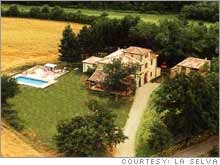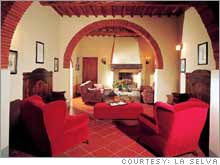 |
| Villa La Selva |
|
|
|
 |
| The reading room |
|
|
|
NEW YORK (CNN/Money) -
When you arrive at La Selva, Riccardo will come down the road to greet you.
If it's morning, chances are he'll be on horseback, taking an early ride around his vineyards, before it gets too hot.
Up in the saddle, Riccardo is a picture of casual elegance, a stylish man whose life seems obviously good. As you look around the Tuscan villa you've just rented from him, you realize that your life is not so bad, either.
A couple of summers ago, I took a memorable vacation at La Selva, in the rolling hills between Arezzo and Siena. A group of us -- 18 people, including kids and grownups -- spent a magical week there.
No other kind of holiday so readily offers the chance to soak up some culture and some rays, while you eat, drink and be merry all the while. It's relaxing, yet stimulating. It's an adventure, but of the most civilized sort.
Plus, it's not nearly as expensive as you might imagine.
Houses are everywhere
The concept of staying in a residence instead of a hotel is not new.
By one estimate, there are more than 1 million such lodging locations throughout Europe. They range from simple apartments in city centers to countryside castles that once housed nobility.
France and Italy offer the most rentals and variety, but houses are widely available in Spain, Britain and many other spots across the continent.
Prices are all over the map, too. You generally rent on a weekly basis, but expect to pay between $120 and $180 per room per night, depending on the house's amenities.
Pools cost more, but are usually worth it. Private cooks are often available -- but that means missing out on the fun of preparing the big meal as a group.
The final cost of your rental could vary a bit, thanks to the plummeting dollar. Since most properties are priced in euros, paying in advance might be a hedge against further declines in the dollar. (Of course, the currency could move the other way, too.)
Whatever your budget, be skeptical about extreme bargains, which tend to be too good to be true. Also ignore the highest priced properties, which may be more luxurious than you really need.
In planning such a trip, you'll eventually deal with a broker representing the property's owner. There are hundreds of them, each with their own regional specialties. Two of the better known vendors are the U.S.-based Parker Company and Holiday-Rentals, a British firm. Italy's Slow Travel offers reviews, helpful information and links to good agents.
A general sense of geography also comes in handy. It's not narrow enough to just say, "Let's do Tuscany."
Where do you want to be? In a particular wine country, such as Chianti or the twin towns of Montalcino and Montepulciano? Near medieval cities like Volterra or San Gimignano?
Beware of distances. What looks close on a map takes much longer than you'd expect to drive on winding, hilly roads.
While at La Selva, for example, some of us made an evening excursion to Da Antonio, a fabled seafood restaurant about 25 miles away.
The meal was incredible. The trip back along single-lane switchbacks was terrifying.
A few do's and don'ts
Done right, the only rule of a villa vacation is that there are no rules. But if you want some guidelines, consider these.
Don't try to do too much. Holidays that cram seven cities into seven nights are terrific fun. But that's exactly what a week at a villa is not about.
Instead, cast out your Type A inner demons and embrace a slower rhythm of life. Wake up in the morning, venture out to a nearby town or village for shopping in small stores or open-air markets. Then go home and just hang out.
Stay flexible. The best part of a villa vacation is that it can be tailored to the individual tastes of the people on it. If you bend to serendipity, the "events" of the trip often take care of themselves.
In other words, different strokes for different folks. Clothes hounds can wander off to the Prada outlet, while wine drinkers tour the vineyards separately. You're on your own time, and there's no guide rushing you through the Uffizi.
Shop the markets. Every sizable town has a market day once or twice a week. Figuring out which ones you want to visit is a good way to order your trip. When it's Pienza's market day, say, use that as a reason to go there. (Don't forget to pick up some of the fabulous local cheese while you're at it.)
On various weekends in cities and the largest towns, there are other bigger markets, at which you can find antiques, clothing, and all sorts of treasures worth shipping back home.
Eat lunch out. Find a trattoria for a long leisurely lunch -- there's no sense in rushing, because everything besides the restaurant will be closed anyway. Afterwards, take a stroll about town, the beloved post-meal passeggiata. Make sure you eat gelato at least once daily.
Eat some dinners at home. Imagine a long marble table, overflowing with cheese, prosciutto and salami. There were olives, artichokes and sun-dried tomatoes drenched in oil. We stuffed zucchini blossoms, and grilled peppers, steaks, and a pork loin. Served with La Selva's own wine, it was a feast fit for a De Medici.
For a final night's meal together, it made a perfect end to a perfect week. Try it sometime.
The Good Life is a weekly column that chronicles products, people and trends in luxury consumer goods, travel, and fine food and drink. Write to: goodlife@money.com.

|